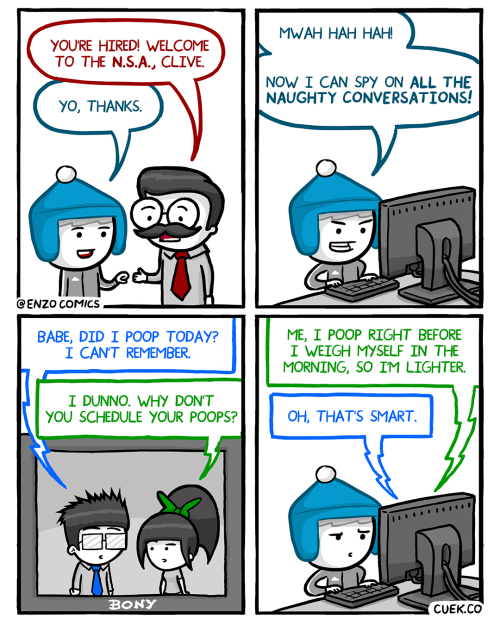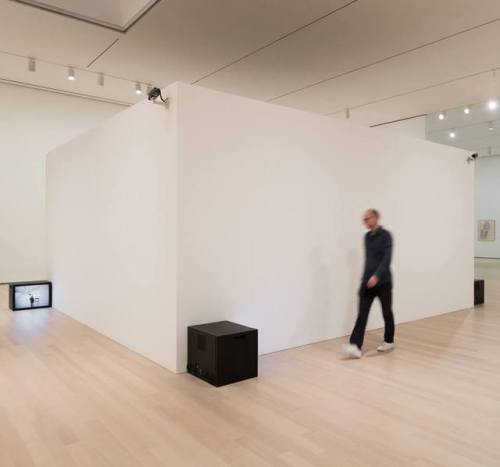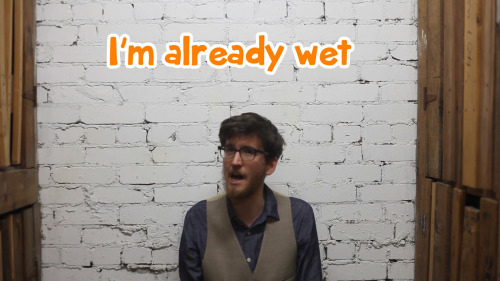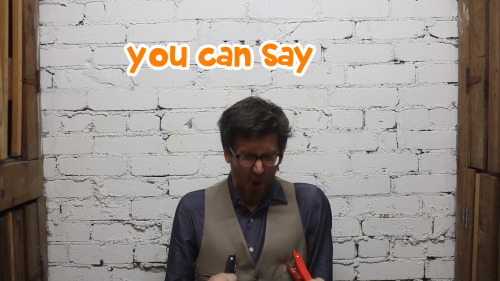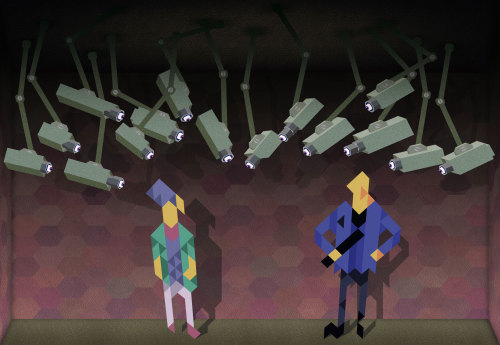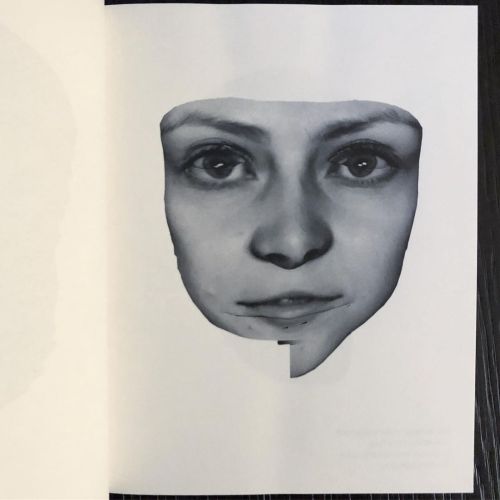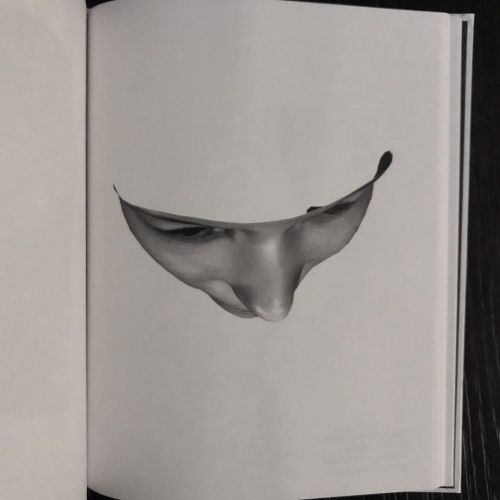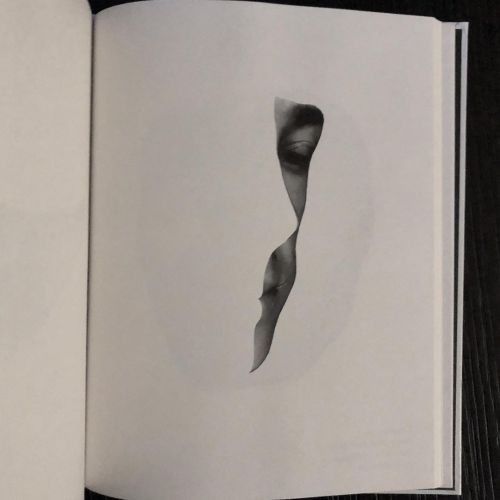#surveillance
Artist Jakub Geltner Installs Surveillance Cameras Into Public Spaces
Czech artist Jakub Geltner installs sculptures of surveillance cameras into public spaces. As an “intervention into the very character of a city”, he’s been working on the ‘Nest’ project since 2011. Living and working in Prague, he created his first installationdirectly in the center of the city, perfectly assimilating into the surrounding architecture and design of the contemporary urban landscape. From then on, his sculptures turned up in places like a former elementary school, a palace and even on the facade of a church. His latest public space installation, Nest No. 5, features a sculpture of surveillance cameras by the sea.
A graduate of fine arts, he says about his project: “The growth process of a nest on the facades of buildings or in different urban spaces can be implemented as a congestion point or as a starting point of an infection.”
Source:iGNANT

Post link
This research project reconsiders writer William H. Whyte’s Street Life Project and seminal study The Social Life of Small Urban Spaces (1980). It sought to understand how the types of new public spaces have changed some 40 years after he published his book and companion film, what has changed in how people use public realm spaces, and what makes well used spaces.
The project first looked at 10 plazas in Manhattan by 10 different designers, constructed or renovated in the last 15 years. The sites range from the type of bonus plazas Whyte was observing, to infrastructural leftovers, alleys, transit plazas, private campus spaces, and tactical urbanist interventions. The team used new analytical tools such as a machine learning algorithm on video footage to develop heat maps describing dwell time, frequent and infrequent usage, and preliminary pedestrian counts.
The team also used some of the same techniques Whyte did—behavioral observations, site measurements, and hand tabulation. The goal was to identify common behavior patterns, collective activity, programming, physical elements, and understand context across the sites in order to inform future public realm design. Findings and methods were published in a booklet called Field Guide to Life in Urban Plazas. Currently, researchers are experimenting with an extension of the New York study on other international sites using infrared data that allows evening site usage to be captured, as well as a higher level of anonymization.
RESEARCH TEAM
Emily Schlickman and Anya Domlesky, XL research and innovation Lab at SWA, Tom Balsley, Chella Strong, Jen Saura, and Hallie Morrison, SWA/Balsley, Anonymous, Data Scientist
Source:SWA Group,Landscape Architecture Magazine
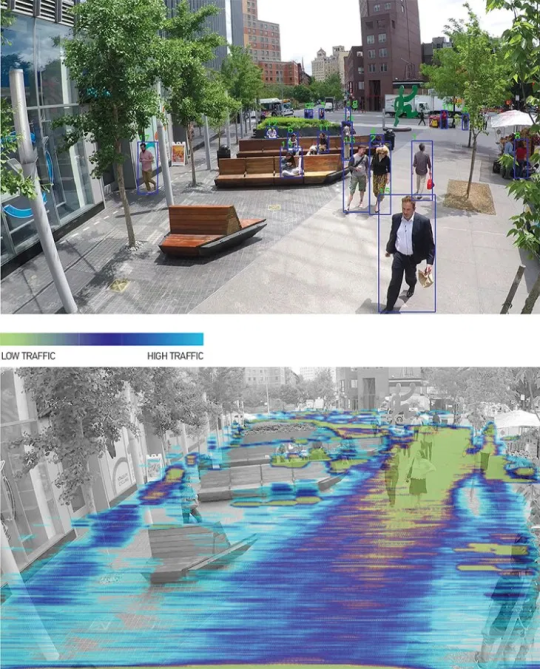

Post link
Refugee Housing: A New Life for Empty Prisons in the Netherlands | Via
Associated Press photographer Muhammed Muheisen has documented many of the men, women, and children displaced by unrest in the Middle East, and followed them as they made their way toward Europe. He often found himself wondering “What happens to migrants once they reach Europe?”, and heard about a program in the Netherlands where the government had started housing refugees in vacant prisons. Years of declining crime rates have left the Dutch government searching for ways to put its emptying prisons to good use, and as an influx of refugees reached the Netherlands, the former prisons have temporarily become their homes. Muheisen spent months trying to gain access to the prisons, then, once he was allowed in, he spent another 40 days visiting and photographing asylum seekers from dozens of countries inside these prisons, as they wait to find out what comes next for them.
Very interesting @ryanpanos. Quite surprised to realize that the prison is an actual Panopticon and this is not mentioned anywhere in the article. I find it gives the whole story an additional reading level and a deeper, maybe darker, meaning. It looks like this is the place: Koepelgevangenis (Dome or Panopticon Prison) in Arnhem.
Post link
The Presidio Modelo was a panopticon prison in Cuba. This photograph was taken in 1926 when it was fully operational.
Post link
Elevation, section and plan of Jeremy Bentham’s Panopticon penitentiary, drawn by Willey Reveley, 1791
The Panopticon is a type of institutional building designed by English philosopher and social theorist Jeremy Bentham in the late 18th century. The concept of the design is to allow a watchman to observe (-opticon) all (pan-) inmates of an institution without their being able to tell whether they are being watched or not.The design consists of a circular structure with an “inspection house” at its centre, from which the managers or staff of the institution are able to watch the inmates, who are stationed around the perimeter. Bentham conceived the basic plan as being equally applicable to hospitals, schools, sanatoriums, daycares, and asylums, but he devoted most of his efforts to developing a design for a Panopticon prison, and it is his prison which is most widely understood by the term.
Bentham himself described the Panopticon as “a new mode of obtaining power of mind over mind, in a quantity hitherto without example.” Elsewhere, he described the Panopticon prison as “a mill for grinding rogues honest”.
Post link
Reports are coming in that many of the major cloud providers have had Chinese spy chips built into the mainboards of their servers.
This is once again a reminder that the Cloud is ultimately just someone else’s computer and your private files don’t belong there.
reminder that literally every electronic device is compromised in some way and the only secure documents are the notes you’ve kept in your head and not told anyone
Do you think it’s possible that anyone else in the world, at this very same moment, is having this very same conversation we’re having right now, about the frequency, shape, and consistency of their last three bowel movements?
Hit the link for a bonus panel: https://cuek.co/728
Post link
5 Online Privacy Tips From Edward Snowden
Protect your data. Protect your privacy. No one deserves to be able to pry into your life without your consent.
OPENING SOON! The designer duo Mike Eckhaus and Zoe Latta navigate fashion, consumption, and creation in Eckhaus Latta: Possessed. The exhibition highlights various aspects of the fashion industry, from advertising and the consumer experience to data collection and surveillance. Learn more on whitney.org.
Post link

Epidemiology allows us to better understand the conditions that lead to sickness and to health so we can better solve public health problems.
To do this, we use surveillance, or the collecting or gathering of information. In public health, this means we’re monitoring data to help inform our work to protect the health of a population.
At the Health Department, for example, we monitor health behaviors, social determinants of health, as well as instances of disease. This includes data related to:
Physical activity
Chronic diseases
Flu-like illness
Lead exposure
New diagnoses of HIV
The number of heat-related deaths
Housing conditions
And much more!

En total serían 25 los países en los que se detectó el funcionamiento de Circles, una una empresa dedicada a proveer tecnologías de vigilancia. Según una investigación realizada por el del Citizen Lab de la Universidad de Toronto, la compañía permitiría la posibilidad de realizar escuchas telefónicas, el rastreo geolocalizado de dispositivos y la implementación de tecnología para el espionaje. En el listado se incluyen siete países latinoamericanos: Chile, Perú, Ecuador, México, El Salvador, Ecuador y Guatemala.
El reporte “Running in Circles: Uncovering the clients of cyberespionage firm Circles”, publicado este martes, afirma que Circles estaría afiliada con NSO Group, compañía israelí responsable del spyware Pegasus. NSO Group declara ofrecer sus servicios en forma exclusiva a los gobiernos, lo que no ha impedido que su tecnología haya sido usada para espiar a activistas, periodistas, defensores de derechos humanos y miembros de la sociedad civil en distintas partes del mundo, incluyendo México.
Según constata el reporte de Citizen Lab, Circles aprovecha una vulnerabilidad en la red SS7 que permite enviar comandos para escuchar llamadas de voz, acceder a mensajes de texto e identificar la geolocalización de dispositivos móviles conectados a la red de telefonía global en cualquier lugar del planeta. según la investigación, para los operadores de telecomunicaciones es complejo distinguir si este tráfico es benigno o malicioso, por lo que se vuelve difícil bloquearlo.
Citizen Lab identificó que los clientes de Circles corresponden a gobiernos con historial de manejar herramientas digitales “para abusos contra los derechos humanos”. Entre los Estados que el laboratorio destaca como probables clientes de Circles figuran siete países latinoamericanos: Chile, donde el sistema es utilizado por la Policía de Investigaciones (PDI); en tanto en El Salvador, Ecuador y Guatemala, la tecnología estaría siendo utilizada por la Dirección General de Inteligencia Civil; en Honduras, estaría a cargo de la Dirección Nacional de Investigación e Inteligencia; al igual que en Perú, que sería implementado por la Dirección de Inteligencia Nacional y México, por la Armada y el Estado de Durango.
Además, Circles estaría en funcionamiento en países como Bélgica, Dinamarca, Australia, Nigeria, Marruecos, Malasia e Indonesia, entre otros.
Surveillance State
Asurveillance state is a country where the government engages in pervasive surveillance of large numbers of its citizens and visitors. Such widespread surveillance is usually justified as being necessary to prevent crime or acts of terrorism, but may also be used to stifle criticism of and opposition to the government.
Examples of early surveillance states include the former Soviet Union and the former East Germany, which had a large network of informers and an advanced technology base in computing and spy-camera technology. But these states did not have today’s technologies for mass surveillance, such as the use of databases and pattern recognition software to cross-correlate information obtained by wire tapping, including speech recognition and telecommunications traffic analysis, monitoring of financial transactions, automatic number plate recognition, the tracking of the position of mobile telephones, and facial recognition systems. $
Post link
“What interested me was the idea that…You don’t try to avoid the resistance. You go straight to it, try to analyze the parts that make you uncomfortable… and then certain physical blocks will be released.” –Bruce Nauman
Bruce Nauman’s invitations to participate in artwork, like the enticing surveillance of “Going Around the Corner Piece” where visitors who pace the perimeter of a sealed room catch glimpses of themselves from behind as they approach its surrounding monitors—now on view at MoMA—turn passive viewers into performers. Will you join in?
[Credit: Installation view, “Going Around the Corner Piece” (1970) in “Bruce Nauman: Disappearing Acts” at MoMA. © 2018 Bruce Nauman/Artists Rights Society (ARS), New York. Photo: Martin Seck]
Post link
AlterNet, March 1, 2015.

Imagine a world without waste. A place where the train always comes on time, where streets are plowed before snow even stops falling, and watchful surveillance cameras have sent rates of petty crime plunging. Never again will you worry about remembering your keys because your front door has an iris recognition system that won’t allow strangers to enter. To some people, this kind of uber-efficient urban living sounds like a utopian dream. But to a growing number of critics, the promise of the “smart city” is starting to seem like the stuff of nightmare.
Smart cities are loosely defined as urban centers that rely on digital technology to enhance efficiency and reduce resource consumption. This happens by means of ubiquitous wireless broadband, citywide networks of computerized sensors that measure human activities (from traffic to electricity use), and mass data collection that analyzes these patterns. Many American cities, including New York, Boston and Chicago, already make use of smart technologies. But far more radical advances are happening overseas. Masdar, in Abu Dhabi, and Songdo, in South Korea, will be the first fully functioning smart cities, in which everything from security to electricity to parking is monitored by sensors and controlled by a central city “brain.”
The surveillance implications of these sorts of mass data-generating civic projects are unnerving, to say the least. Urban designer and author Adam Greenfield wrote on his blog Speedbird that this centralized governing model is “disturbingly consonant with the exercise of authoritarianism.” To further complicate matters, the vast majority of smart-city technology is designed by IT-systems giants like IBM and Siemens. In places like Songdo, which was the brainchild of Cisco Systems, corporate entities become responsible for designing and maintaining the basic functions of urban life.
Smart cities are predicated on the neoliberal idea that the market can fix anything—that companies can manage cities better than governments can. Their advocates claim that they will enhance democratic participation by relying on crowdsourcing and “civic hacking projects” that allow locals to use newly available data to solve municipal problems. But they ignore the fact that private corporations are the ones measuring and controlling these mountains of data, and that they don’t have the same accountability to the public that government does.
InTheNation last year, urban theorist and author Catherine Tumber expressed some of the principle concerns about smart tech, reviewing Anthony Townsend’s Smart Cities: Big Data, Civic Hackers, and the Quest for a New Utopia. (Full disclosure: I fact-checked the review). Tumber asserts that “the economics of ‘smart’” are in keeping with “the ramped-up market rationalization carried out by finance monopoly since the Civil War, culminating in a minimally civic world fit only for…the unencumbered self.”
I caught up with Tumber via telephone at her office at Northeastern University’s School of Public Policy and Urban Affairs, where she is a visiting scholar, to talk about what the rise of smart cities means for our understanding of urban life.
Editor’s note: This interview has been condensed and lightly edited for clarity.
Allegra Kirkland: How did you first become acquainted with the concept of smart cities?
Catherine Tumber: I had been aware of them kind of through the ether because I pay attention to cities, and I’m very much aware of what’s going on in the digital world in a broad sense. I think it’s quite dangerous actually, in all kinds of ways….
I thought Townsend did a good job laying out what the fault lines are: the big digital systems corporations like Siemens and Cisco and IBM versus what these hacker “democratic heroes” are trying to do. I found that to be useful but I wasn’t persuaded that they aren’t all part of the same sort of dangerous direction of things.
AK: These digital innovations are supposed to be all about access to information and transparency, but it seems like many people don’t even know these initiatives are going on. Chicago, Barcelona, and all of these other urban centers are now considered “smart cities” but I feel like most people don’t think of them that way.
CT:I think people are only vaguely aware.
AK: It seems like these major urban initiatives are being conducted largely out of the public eye, without public oversight or involvement. Maybe there are some smaller initiatives being carried out by civic hackers, but the major ones have to be implemented by corporations or the government because regular people don’t have the ability to build that kind of infrastructure.
CT: Right, these are major infrastructure projects.
AK: And there’s no means of opting out. Once a city integrates smart technology, your information gets caught up with all the rest, whether you want it to be or not.
CT:Exactly. And also what’s often not taken into account, and I guess you have to live long enough to really see it—though it’s happening very quickly in our time—is that when you introduce a whole new paradigm of infrastructure, the old infrastructure dies. So it ends up being coercive. At some point, you really have to participate in it or you are not able to execute that function, whether that function be communications or entertainment or transportation or energy.
For example, if you did not really want to be available on a cell phone at any given moment or own one, and wanted to simply rely on a landline, that was fine as long as you were home. But they stripped out all of the phone booths. That was really completed by around five years ago. So it really forces your hand quite a bit.
AK: You seem skeptical of the idea that smart cities are inherently democratizing—that they are sites of greater sociability and inclusion. Does that seem plausible to you?
CT: I think that digital technology, aside from providing all kinds of information that is trackable, holds up the false promise of greater democratic participation. It holds out a sort of false sense of moral agency, for one thing. The argument as I understand it is that crowdsourcing provides people with a different, less curated sense of democratic participation. It involves reaching out to individuals, so it’s a version of democratic practice. I think the jury is still very much out on whether that is persuasive.
Part of what I think is important and rich about democratic culture as a living tradition is that it brings people of very different backgrounds and types together in surge spaces. And crowdsourcing tends to be consistent marketing in that it excludes whole groups of people, just because of the way it works. It’s not even intentional.
AK: Because of the kind of people who get surveyed, who are aware that these kinds of civic campaigns are going on and would get involved?
CT: Yeah. I find that to be somewhat dubious…for the long-term health of the civic project.
AK: It seems like there’s a fundamental split between people who think there is something organic and inexplicable about the ways human beings come together in cities, and those who believe that all human behavior is quantifiable—that we can rely on data to understand how humans interact. Which side of the line do you fall on?
CT:Digital technology and its use compresses experience. It tends to lead to niche cultures; it tends to lead to a sense of being untethered, as if that’s the golden pathway to real freedom. There are several traditions of political philosophy that hold that its important to be tethered so that you have a sense of the limits of yourself and of what it is that humans can do in the time that they have on this earth. This sense of endless freedom can lead to a very false sense of utopian promise that is simply unrealistic and unwanted. It’s yet another way that we’ve decided to take a pause from history and what history has long told us.
There are some things that you really don’t play with. People have acquired great wisdom over the ages—across the globe, this isn’t just a Eurocentric thing—about what it means to travel and to leave home and to come back. These are all the great stories and myths and fables. Technology kind of flattens all of that.
AK: This is sort of a related question, but what do you think are the primary things smart cities take away from the people who live there? What do we lose in these sorts of manufactured urban environments?
It makes me think of the complaints about the gentrification of places like New York City. Michael Bloomberg created new green spaces in Times Square and along the waterfront, made city services more efficient, rezoned districts, and now we have this sanitized, business-friendly, soulless city. The neighborhoods look the same; there’s no mixing of social classes, no weird dive bars. So you’d think smart cities, with their emphasis on homogeneity and efficiency, would be equally off-putting to people.
CT:I think it’s a matter of the convenience of it and the novelty of it. But smart technology is relatively new and there are so many unexamined consequences, as I think there are with any major technological change like this.
I think that we’re only beginning as a culture to wince a little and take a second look at this. … There really hasn’t been any sort of consensus about what the right manners are in using these technologies. Across the world for time immemorial, every culture had some understanding of manners, and I don’t mean that in the prim Victorian sense. But just some ways in which you convey unspoken, coded assumptions about respect and caring and common courtesy and stuff like that. We haven’t had that conversation here. …The main point is that there are real unintended consequences of this.
AK: The corporations behind smart cities throw around all these statistics about how smart technology reduces crime, reduces waste. So it makes you feel like a Luddite to say that you’re uncomfortable with these technologies because there is all of this evidence that they’re successful. But I feel like there’s a difference between using technology to fix a specific urban problem, like Rio de Janeiro using weather tracking to forecast flash floods, which are a major problem there, and places like Songdo, where you’re really rebuilding the concept of the city from scratch and dictating how people should live.
CT:Yes, they’re riddled with totalitarian overtones, and that’s built into it, it’s part of the built structure.
AK: So do you think smart city initiatives are not necessarily problematic, and it’s just when they’re applied on the scale of an entire city that it gets out of control?
CT: I’m mainly concerned with this assumption that this is new, this is shiny, this is innovative, to use everyone’s favorite buzzword, and that we should just do it. A lot of people don’t really understand what’s involved. There’s a tendency to have it sort of inflicted on people, and part of that is the way the business model for digital technology, at least at this point in time, works, which is to make everything cheap. It doesn’t cost the public very much to say, oh, okay, because there’s not much of a pricetag on it yet. Part of the reason why it’s so cheap is that so much of the work is based on volunteer labor.
So many of these civic hackers, all these projects and apps they develop, so much of that is based on free labor. People try to frame that as a sort of revival of Tocqueville—voluntary associations and all that stuff. But instead it’s just downright free labor, like unpaid internships or something. That’s why I’m very skeptical of all of this; this is really just another variation on the sort of neoliberal business model that we’ve been using now for the past 35 years and has grown out of control. This is just another iteration of that with nice shiny technology attached to it. Americans are always suckers for technological determinism.
AK: Sure. I feel like privatization initiatives in cities have multiplied in recent years, with cities selling stakes in public housing to private developers—
CT:And all the stuff Rahm Emanuel is doing in Chicago.
AK: Exactly. It seems like smart cities are sort of the ultimate example of the corporate-designed urban environment. Should that inherently be a cause for concern? It goes without saying that corporations don’t always have the best interests of people in mind. And places like Songdo were designed to have minimal regulatory barriers. They prioritize technological innovation and wealth generation, so it seems like they could really deepen existing economic inequality. If you’re not part of those spheres, you don’t really have a place in these cities.
CT:To really take on wealth inequality and the kind of ravaging done by the spoiling land use policies that we’ve had in place since after World War II, we need to have a body of ideas and practices that have a clearly defined sense of what their political vision is: what the good life is and how to get there. What are our fundamental values, our limitations? All of this smart city design is apolitical. That’s the problem. The longer it seeps into our political culture, the more it will drain the public imagination of the next generation, of what a real political movement looks like and why politics are important.
AK: It also seems like the obligation of government to provide essential public services like housing is reduced. It becomes the responsibility of corporations and developers, so there’s less accountability, less control over pricing and over the data the companies acquire.
CT:Then there’s all this debate about regulations—which industries require more or less. These are all very difficult questions of practicality and philosophy. And I fear that our political discourse and understanding of the world is being degraded and coarsened by the uncritical dissemination of a digital substitute for a real politics.
AK: Another thing I wanted to bring up is the surveillance concern. I read a quote from the mayor of Rio, which is a smart city, saying “The operations center allows us to have people looking into every corner of the city, 24 hours a day, seven days a week.” He meant it as a positive, but that’s a sort of terrifying statement. What are your thoughts about the surveillance implications of smart technology?
CT:All these sensors will and are being used to invade our privacy. There are good and bad things about that. You know, here in Boston we had the marathon bombers and they were very quickly apprehended, partly because that area is so rigged up with security cameras. We have to decide whether it’s worth it.
Another thing I’ve been concerned about is thinking about the difference between Aldous Huxley and George Orwell. You know, George Orwell talked about Big Brother and the authoritarian state, the invasion of privacy. Huxley talked more about the internalization of oppression, and I’m in some ways even more concerned about that. It’s a cultural critique of the way we internalize and accept the terms of our lack of freedom. We accept the deprivation that totalitarian movements end up exacting on us. So we end up being our own worst enemies. It’s almost like we don’t even need Big Brother.
AK: Sure. We voluntarily give up so much information about ourselves.
CT:When I see people walking around in public as though they’re wearing a blindfold because they’re so absorbed in another world on their devices, that has the look to me of self-degradation and degradation of the public realm that is more effective than security cameras. Because people won’t resist. They’re not even aware of their surroundings, just as animals moving through the world. So why would they be able to muster whatever it takes to resist the invasion of privacy by the state or by corporations, for that matter? It just all represents such a contraction of democratic culture to me. It worries the heck out of me.
Some particularly ridiculous moments from my new “Hello NSA” music video. I picked some because I was proud of the wordplay and others because there were jumper cables on my nipples. I’ll leave you to sort out which is which.
Link: https://www.youtube.com/watch?v=1z7Nmrn1WcI&list=PL283994E151539F68
Post link
If you like wordplay, guitar solos, and criticism of surveillance states, check out my new music video ft. a love song using the NSA watchwords!
Mass surveillance of the internet by intelligence agencies is “corrosive of online privacy” and threatens to undermine international law, according to a report to the United Nations general assembly. The critical study by Ben Emmerson QC, the UN’s special rapporteur on counter-terrorism, released on Wednesday is a response to revelations by the whistleblower Edward Snowden about the extent of monitoring carried out by GCHQ in the UK and the National Security Agency (NSA) in the US. Emmerson’s study poses a direct challenge to the claims of both governments that their bulk surveillance programs, which the barrister finds endanger the privacy of “literally every internet user,” are proportionate to the terrorist threat and robustly constrained by law. To combat the danger, Emmerson endorses the ability of Internet users to mount legal challenges to bulk surveillance. http://goo.gl/usDwXV

Always watching. This hooded crow had a nest in a nearby tree.
more on my art books instagram page
Adam Broomberg & Oliver Chanarin - Spirit is a Bone
2015, MACK, first edition (signed). Book came wrapped in tissue paper.
The portraits in this book were produced using advanced facial recognition technology that’s being used in most cities around the world, developed by engineers in Moscow from existing systems built to recognize car plates. These so called ‘non-collaborative portraits’ are more three dimensional data maps than photographs, where no human contact is registered: there’s a total negation of humanity, they’re essentially some sort of digital death masks. Broomberg & Chanarin have constructed their own taxonomy of portraits in contemporary Russia, including Pussy Riot members and other Moscow citizens.
Post link


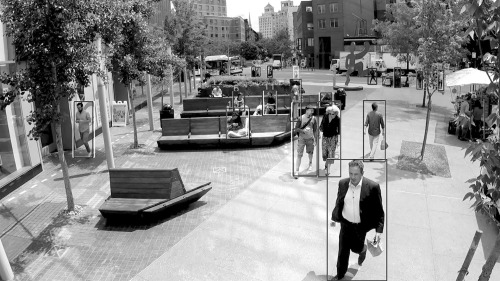

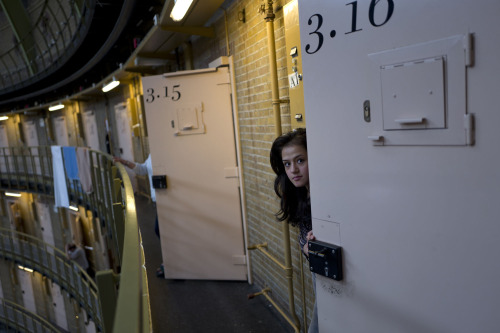





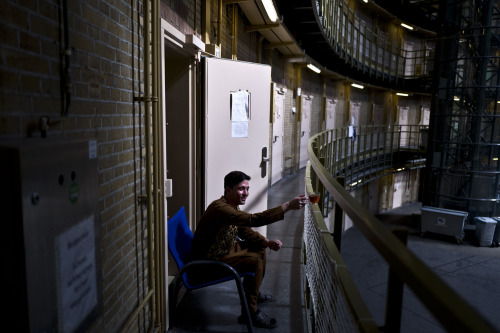


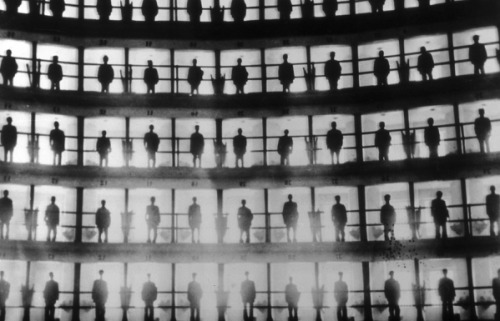

![Harun Farocki, War at a Distance [Erkennen Und Verfolgen] (2003) Harun Farocki, War at a Distance [Erkennen Und Verfolgen] (2003)](https://64.media.tumblr.com/f01733bb7523f3bcb46b9e05aac12975/tumblr_mymapbDuG41s1o9cdo1_400.gif)
